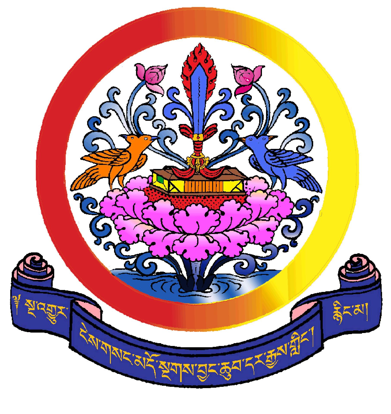Cultural and Social
Ngesang Dongag Jangchub Dargyeling Monastery
Since our culture and spiritual practice are so intertwined that it is almost impossible to completely separate the two. Spirituality (Dharma) is so much ingrained in our culture and tradition that it has become our way of life. Our culture and tradition got evolved and refined throughout the centuries due to the rigorous practice and following of the tenets and way of life enshrined in Dharma shastras. For this very reason Khen Rinpoche at the very beginning, in the year 2003, started its one of the most important long cherished tasks of constructing monastery building cum cultural center,

which will be the focal point of the diffusion of knowledge and cultural preservation. In February 2003, during his kind visit to this region, His Holiness the 14th Dalai Lama laid the foundation stone for the monastery building and planted a tree in the monastery campus. The same year, a week after the H.H. the Dalai Lama’s visit, His Holiness The Pema Norbu Rinpoche, the supreme head of the Nyingma sect of the Tibetan Buddhism visited the monastery and consecrated and blessed the land by performance of religious rites and rituals. Being a Charitable Society, Pema Mani Charitable Trust has established a center for learning and higher studies, which was a long cherished goal of the members and people of this region. Monastery building was crucially needed for performing religious and cultural programs and to promote and preserve age-old tradition of this region. The construction of the three-storey main temple building was immediately started in the year 2003 with small donations received from ardent followers, general public and contribution from trustees and members of the society. Monastery complex, has served as an important center for learning and cultural activity for the local community and also to the rest of the world.

Ethnographic Museum of Buddhist Culture and History
Khen Rinpoche seeing inadequacy and futility of teaching younger generations about their culture and tradition only through books and lectures has come out with the brilliant idea of establishing this magnificent museum of ethnography pertaining to both local and Buddhist art and culture, which not only will encourage and enthuse younger generation to learn and understand their hoary past but will also let the younger generation know and feel what they are missing. The museum is not only to showcase but also to preserve the dwindling cultural and historical inheritance, which is pushed to
the brink of existence by the rapid onslaught of modern day internet and movie influence youth culture. The purpose is also to appreciate, judicious use and handling with full transparency of all the articles and objects both antiques and contemporaries generously donated to Khen Rinpoche by his sponsors and benefactors.
This ambitious project of the museum at such remote and backward area is to create a widow to the world’s rich and diverse arts and cultural heritage. The Chairman of PEMA MANI CHARITABLE TRUST wanted this endeavor to be the valued property of inheritance for the coming generations. He has decided to build a museum that not only would attract people and tourists but also to educate and introduce local people to the rich and hoary religious and cultural history of Himalayan people. For that purpose, PEMA MANI CHARITABLE TRUST has allotted one 60 X 35 feet room for the museum on the first floor of the main temple building adjacent to the library.
Cultural Events
PEMA MANI CHARITABLE TRUST in order to bring unity, brotherhood and understanding amongst the different people of the locality organizes and sponsor three days cultural fete every year on the third, fourth and fifth day of the 12th Month of the Buddhist Lunar calendar. During these three days, people from all walks of life and from all the communities take part in their traditional dance and song. During these three days of vibrant and colorful cultural fete, people from all communities, enthusiastically take part in service as well as Cultural Shows, games and sport competition.


Lingdro Performing Troupe
“Lingdro Dechen Rolmo” roughly translated as “The great blissful dance and music of the Ling.” A tradition of dance and song invoking, emulating and eulogizing the sacred way of life of the kingdom of Ling passed down since its origin in the tenth century. The particular Lingdro tradition that we follow and practice today was originally composed and propagated by Jamgon Mipham Rinpoche with the prophecy that whoever and wherever this sacred dance and song is practice and perform, it will bring peace, prosperity and auspiciousness to that land and the people. It is believed that who
ever uphold this tradition will accomplish all the four activities swiftly and all wishes and aspiration will be fulfilled without any hindrances and obstacles.
Following the noble tradition and advice of the sublime beings of the past, the chairman of pema mani charitable trust formed lingdro performance troupe and he personally prepared gears, printed song books and stitched all dresses under his guidance. He invited professional trainers and teachers from Orissa to train our local dancers and singers.
His hard work and dedication has given birth to a vibrant and thriving tradition of Lingdro dance and performance in Tuting, Pema Kod.

Mani Dungkhor (Prayer Wheels)
Pema Mani Charitable Trust constructed a hall housing five giant prayer wheels containing billions of sacred mantra, where people of all ages come to turn the wheels and reap the benefits of accumulating good merit as well as some physical activities also.

Stupas
Pema mani charitable trust constructed a cluster of 13 Stupas with the footpath (pradakhshina) and green landscape for the benefit of devotees, who come for circumambulation of the stupas. These stupas are special hemispherical and geometrical symbols (figure) containing important relics of holy and enlightened masters of the past beside holy texts and artifacts. Thousands of people visit this site everyday for circumambulation and relaxation. This place is considered to be very potent and powerful for accumulating positive energy and virtue.
